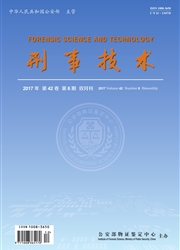

 中文摘要:
中文摘要:
目的以随机模拟法分析混合样本的表观组分数,探讨混合样本组分数的测算规律。方法首先,在ID(Identifiler)系统中以随机模拟法分别模拟2~7组分混合样本100万个,统计混合样本表观组分数累积概率(CPA)的分布。其次,自行推导2组分混合样本中表观组分数为1的单基因座概率PA2-1和表观组分数累积概率CPA的公式。继之,设计两组模拟实验,以模拟值对比公式值的方式,分别对两公式进行实验验证。最后,提出非混排除率(PEM)和累积非混排除率(CPEM)概念,以及CPEM的近似值计算公式,计算ID系统的CPEM近似值。结果本文模拟计算获得了ID系统2~7组分混合样本CPA的分布。自行推导的两个公式均符合模拟实验验证。ID系统中的CPEM近似值为1-1.23298×10-9(0.999999998767)。结论本文CPA分布及其公式推导在混合样本组分数估测中具有一定的应用价值,建议以累积非混排除率(CPEM)作为单组分样本排除其为混合样本的鉴别指标,所建立的相应近似值计算方法,可用于法医学实践。
 英文摘要:
英文摘要:
Objective To analyze the apparent component number from the mixed sample of forensic genetic evidence with stochastic simulation for exploring the inherent regularity on the evaluation of the component number of such mixed sample. Methods With stochastic simulation into ID(Identifiler) system, one million STR genotypes of mixed samples, owning 2-7 components, were engendered and analyzed. The distribution of cumulative probability of apparent component number(CPA) in the mixed samples of 2-7 components was calculated by the self-designed software into ID system. Probability formula of apparent component number of the mixed sample, comprising two actual components but showing one apparent component(PA2-1) on a single-locus, was derived along with the cumulative probability formula of apparent component number of mixed sample(CPA) for the multi-loci. The two formulas were then all empirically validated on the calculation values of formula and simulation experiments by correlation method through two sets of simulation experiments. Finally, the concepts were proposed on the probability of excluding mixture(PEM) and cumulative probability of excluding mixture(CPEM). The approximate calculation formula of CPEM was put forward, and tested with the CPEM asymptotic value in ID system. Results CPA distribution of mixed samples owning 2-7 components was calculated with stochastic simulation approach in ID system. Two formulas were all in accordance with the simulation experiments. The approximate value of CPEM was 1-1.23298×10-9(0.999999998767) in ID system. Conclusion CPA distribution and the formulas built here have certain applicability for the evaluation of component number of mixed sample. The CPEM can be suggested as the appraisal indicator for distinguishing the sample of single component from that mixed, and the method for calculating the CPEM is able to apply into practice of forensic genetics.
 同期刊论文项目
同期刊论文项目
 同项目期刊论文
同项目期刊论文
 期刊信息
期刊信息
